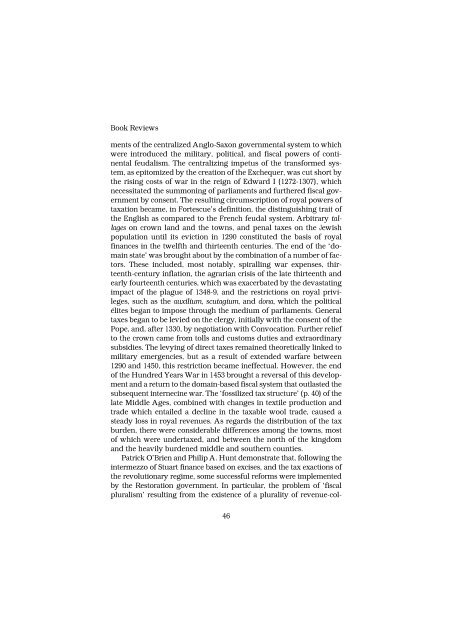Download - German Historical Institute London
Download - German Historical Institute London
Download - German Historical Institute London
You also want an ePaper? Increase the reach of your titles
YUMPU automatically turns print PDFs into web optimized ePapers that Google loves.
Book Reviews<br />
ments of the centralized Anglo-Saxon governmental system to which<br />
were introduced the military, political, and fiscal powers of continental<br />
feudalism. The centralizing impetus of the transformed system,<br />
as epitomized by the creation of the Exchequer, was cut short by<br />
the rising costs of war in the reign of Edward I (1272-1307), which<br />
necessitated the summoning of parliaments and furthered fiscal government<br />
by consent. The resulting circumscription of royal powers of<br />
taxation became, in Fortescue’s definition, the distinguishing trait of<br />
the English as compared to the French feudal system. Arbitrary tallages<br />
on crown land and the towns, and penal taxes on the Jewish<br />
population until its eviction in 1290 constituted the basis of royal<br />
finances in the twelfth and thirteenth centuries. The end of the ‘domain<br />
state’ was brought about by the combination of a number of factors.<br />
These included, most notably, spiralling war expenses, thirteenth-century<br />
inflation, the agrarian crisis of the late thirteenth and<br />
early fourteenth centuries, which was exacerbated by the devastating<br />
impact of the plague of 1348-9, and the restrictions on royal privileges,<br />
such as the auxilium, scutagium, and dona, which the political<br />
élites began to impose through the medium of parliaments. General<br />
taxes began to be levied on the clergy, initially with the consent of the<br />
Pope, and, after 1330, by negotiation with Convocation. Further relief<br />
to the crown came from tolls and customs duties and extraordinary<br />
subsidies. The levying of direct taxes remained theoretically linked to<br />
military emergencies, but as a result of extended warfare between<br />
1290 and 1450, this restriction became ineffectual. However, the end<br />
of the Hundred Years War in 1453 brought a reversal of this development<br />
and a return to the domain-based fiscal system that outlasted the<br />
subsequent internecine war. The ‘fossilized tax structure’ (p. 40) of the<br />
late Middle Ages, combined with changes in textile production and<br />
trade which entailed a decline in the taxable wool trade, caused a<br />
steady loss in royal revenues. As regards the distribution of the tax<br />
burden, there were considerable differences among the towns, most<br />
of which were undertaxed, and between the north of the kingdom<br />
and the heavily burdened middle and southern counties.<br />
Patrick O’Brien and Philip A. Hunt demonstrate that, following the<br />
intermezzo of Stuart finance based on excises, and the tax exactions of<br />
the revolutionary regime, some successful reforms were implemented<br />
by the Restoration government. In particular, the problem of ‘fiscal<br />
pluralism’ resulting from the existence of a plurality of revenue-col-<br />
46













